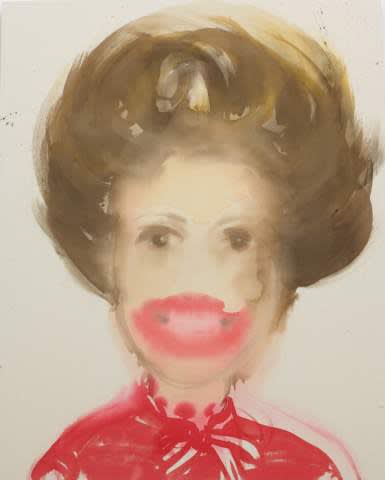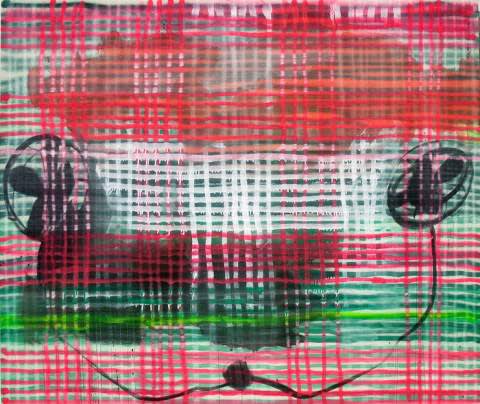There was a time before trigger warnings and safe spaces when it seemed the best way of addressing hypocrisy, lies, and, most of all power, was to find a way to undermine the authority of whatever it was you were pissed off at by getting into it, subverting it, and most of all, participating in the dialogue of culture. It might be called irony, satire, or parody, or, for lack of anyone ever defining it, “The Poetry of Hating Shit.” Some of our cultural institutions, like Saturday Night Live, Punk Rock, and the writings of Hunter S. Thompson, Bret Easton Ellis, and David Foster Wallace are examples that have become canonical. Painting, as well, can show us something we think we know in a new way, taking known visual forms and re-presenting them, using the vocabulary of something oppressive and liberating new ideas. The current work of Liz Markus shows this tradition has not abated.
I have known Markus for nearly two decades, and am always amazed with the ways she draws from a disparate variety of sources then weaves them together with such clarity that her paintings seem to have always been there. The past couple years have been some of her best in the studio, and it seemed to be the right time to reconsider what she has done and where she will be taking us in the future.
Bradley Rubenstein: I want to talk about some of the recent paintings, the Trump ones. But let’s frame that discussion, in the context of your work, with two groups of work that I think are important. First was your show at ZieherSmith, Are You Punk or New Wave?, and at the other end of the spectrum was your Girlfriends of the Rolling Stones paintings.
Liz Markus: Yeah, they both express the rebellious side of me. The Punk/New Wave show specifically reflected my experience of the 80s, both in high school and art school. “Are you Punk or New Wave?” was an often-heard question in high school as we tried to best understand and categorize ourselves. I think of New Wave as more conceptual and Punk as more angry. Both served as a counterweight to our preppy lives at a private, all-girls school. In the show I think of Plaid, the Johnny Rotten paintings, and Kate as punk and maybe especially Relax and War as New Wave, though I wasn’t specifically painting them to fit into those categories. My portrait of Basquiat makes a good visual bridge to the Girlfriends of the Rolling Stones portraits. As my Punk/New Wave paintings were a reaction to my more staid daily life in prep school, the Girlfriends served as a release from the stringent women in my portrait series of iconic socialites. The latter were very buttoned up and sought to appear perfect. The Girlfriends are sexy, powerful, and though I named the series for whom they dated, they are women who are really interested in pleasing themselves rather than a man.
BR: You folded a lot of ideas into simple images. I remember being really struck by the pieces, your use of color was spot right, and it was both color and subject matter coming together perfectly. In a similar way the Girlfriends pictures use period colors, like something remembered, but you weren’t there then, so there is this weird immediacy combined with a sense of distance.
LM: Yeah, I liked how punks took plaid away from conservatives and made it their own flag. War in pink colors is really a nod to ACT UP’s pink triangle in their Silence = Death posters. Using the words “relax” and “war” (both Frankie Goes To Hollywood songs) at a grand scale was actually inspired by Ellsworth Kelly’s New York, NY painting that hung in the Albright-Knox when I was growing up in Buffalo. I love how that painting flickers between abstraction and representation. Mine failed on that score. They don’t flicker. I still love them.
BR: You folded a lot of ideas into simple images. I remember being really struck by the pieces, your use of color was spot right, and it was both color and subject matter coming together perfectly. In a similar way the Girlfriends pictures use period colors, like something remembered, but you weren’t there then, so there is this weird immediacy combined with a sense of distance.
LM: Yeah, I liked how punks took plaid away from conservatives and made it their own flag. War in pink colors is really a nod to ACT UP’s pink triangle in their Silence = Death posters. Using the words “relax” and “war” (both Frankie Goes To Hollywood songs) at a grand scale was actually inspired by Ellsworth Kelly’s New York, NY painting that hung in the Albright-Knox when I was growing up in Buffalo. I love how that painting flickers between abstraction and representation. Mine failed on that score. They don’t flicker. I still love them.
BR: There is also something in your work that reminds me of Schnabel—combining portraits and genre work, with strange personal references.
LM: Ah, Schnabel. I hated his work when I saw it in the 1980s. Then, in grad school in 1995 I fell head over heels for it. I love the epic scale, both of his work and his ego. He is like a wizard who can summon great forces to come together on the canvas. I think you’re right about our work relating both in our variety of genre and also in our attention to beautiful and poetic mark making. I think one of the benefits of Post Modernism is our ability to sort of pick through the history of painting, cafeteria style. I insist on my right to paint whatever I want, whether it’s “confusing to collectors” or not. My “side paintings” are some of my favorites. That said, incorporating portraiture with genre work with strange personal references is straight out of Picasso.
BR: There is something in your work that keeps it from being straight satire, but there is a sense of exploring celebrity, or taking the piss out of “high art” there.
LM: Yes. There was a pervasive gallows humor in my house growing up. It came from my dad. He was a holocaust survivor with a wicked sense of humor. I’m not sure he used it to get through the holocaust. I doubt it. I’m guessing he had it before and that it came back, and maybe that’s what kept him buoyant and happy in the face of having witnessed a total loss of humanity.
At any rate, it’s this dark humor through which I view life. I think that comes across in the work not because I’m trying to imbue the work with it but because all of my work is somewhat biographical, in that I place a high value on painting from within. In 1999 I made a wall painting with the words “It’s all about how Liz Markus responds to work.” I had taken the gray grid of modernist graphic designer—I think it was Josef Müller-Brockmann—and created my own modernist poster about myself. There were two identical grids on each side of a door. The only difference was that one was matte and one was glossy. I had used the vocabulary of graphic design because I was thoroughly researching it to teach myself about design for my day job. But I also fell in love with it. So it came out in my artwork. I wanted to explain, within an artwork, what it was that my work was all about. That it is my response to something, to other art, to what’s around me, to being a woman, to fashion, to politics. My take on all of those things is cynical but hopeful. There is a great t-shirt I have from Buffalo that I think succinctly explains my work. There is an emblem with a buffalo in the middle, and around the circle it says “BUFFALO, CITY OF NO ILLUSIONS.”

